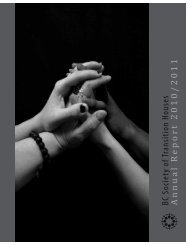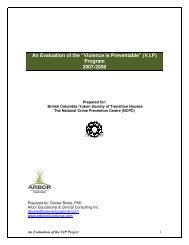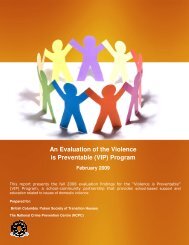reducing barriers to support - BC Society of Transition Houses
reducing barriers to support - BC Society of Transition Houses
reducing barriers to support - BC Society of Transition Houses
You also want an ePaper? Increase the reach of your titles
YUMPU automatically turns print PDFs into web optimized ePapers that Google loves.
violence, some women with disAbilities find themselves addicted <strong>to</strong> pain medication used <strong>to</strong> get by on a<br />
day-<strong>to</strong>-day basis. Others find substance use a means <strong>of</strong> coping with the loss <strong>of</strong> control they feel, not only<br />
from the violence, but from the disAbility as well.<br />
While many programs consider themselves accessible, <strong>of</strong>ten this refers only <strong>to</strong> wheel-chair accessibility<br />
and women who may need visual aids or sign language interpreters may not be considered. Women with<br />
learning disAbilities may find navigating systems, especially where paperwork is involved, frustrating and<br />
downright challenging. In addition, Chappel notes, “program policies sometimes create unique <strong>barriers</strong><br />
for certain women with dis[A]bilities, such as those who may not be able <strong>to</strong> be substance-free before<br />
entering treatment, who have a need for personal care or who may not be able <strong>to</strong> fully participate in<br />
strenuous group models”.48<br />
AGE<br />
“Both young women and elderly women face particular <strong>barriers</strong> that magnify other<br />
forms <strong>of</strong> marginalization. Both have limited economic and social power, and services<br />
are <strong>of</strong>ten not particularly appropriate for either age group.” 49<br />
Older and younger women <strong>of</strong>ten face financial <strong>barriers</strong> that leave them more vulnerable <strong>to</strong> violence and<br />
make it more difficult <strong>to</strong> leave an abuser. Both groups are more likely <strong>to</strong> experience violence than the<br />
general population. As women grow older they become “increasingly vulnerable <strong>to</strong> violence from<br />
partners, other family members and caregivers”. 50 Compared <strong>to</strong> younger women, they are more<br />
vulnerable <strong>to</strong> financial abuse. 51 Violence against older women is <strong>of</strong>ten classified as elder abuse, even<br />
though the features may be the same as violence against younger women. Yet, many agencies<br />
addressing elder abuse are unequipped <strong>to</strong> address violence against women, sometimes focusing on the<br />
financial abuse <strong>of</strong> men and on women who are caregivers as perpetra<strong>to</strong>rs. 52<br />
Older women may be hesitant <strong>to</strong> report abuse for fear <strong>of</strong> being placed in an institution if they require<br />
the abuser <strong>to</strong> care for them. Women who are able <strong>to</strong> access <strong>support</strong> are sometime put in unsafe<br />
positions by those who they seek <strong>support</strong> from. Older women are prescribed more medications for<br />
mental wellness than any other age group. Specifically, older women are over-prescribed<br />
benzodiazepines, which can dull a woman’s senses and affect her ability <strong>to</strong> assess her safety. 53 Finally,<br />
older women are less likely <strong>to</strong> access VAW services than women in other age groups. When they do<br />
11






